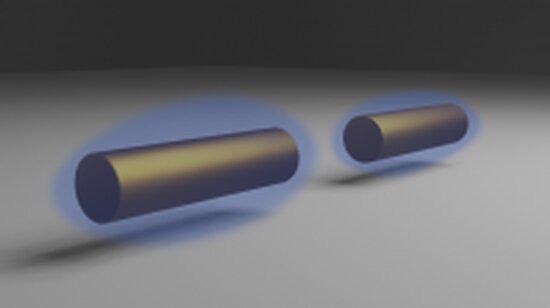Dec 17 2020
A group of researchers has now resolved the longstanding question of how electrons move collectively as a group within cylindrical nanoparticles.
 A pair of cylindrical gold nanoparticles, where the plasmonic excitations are represented by the clouds surrounding the nanoparticles. Image Credit: University of Exeter.
A pair of cylindrical gold nanoparticles, where the plasmonic excitations are represented by the clouds surrounding the nanoparticles. Image Credit: University of Exeter.
The new study offers an unpredicted theoretical advancement in the field of electromagnetism, with further prospects for research on metamaterials.
The group of theoretical physicists, from the University of Exeter and the University of Strasbourg, developed an exquisite theory that explains how electrons move together in small metal nanoparticles with a cylindrical shape.
The study has offered new insights into the ways light and matter interact at the nano-level, with implications for achieving future nanoscale devices that leverage nanoparticle-based metamaterials with splendid optical properties.
The ionic core of metallic nanoparticles is positively charged, where a cloud of negatively charged electrons swirls around it. The electronic cloud gets displaced when light shines on such a metallic object.
This displacement makes the entire group of electrons to be set into oscillation with respect to the positive core. The electrons oscillating back and forth act like a single particle (that is called a quasiparticle), or a 'plasmon.'
The plasmon is mainly characterized by the frequency at which it oscillates, called the plasmon resonance frequency.
In modern electromagnetism, a basic task is to explore how the plasmon’s resonance frequency varies based on the geometry of its hosting nanoparticle. In general, it is considered that analytical theory can be used to describe only certain specific nanoparticle geometries, without recourse to laborious, time-consuming numerical computations.
It is widely regarded that the list of geometries that allows an analytical description is very short and includes only ellipsoidal and spherical nanoparticles.
This aspect is largely undesirable because of the experimental ubiquity of cylindrical nanoparticles, which emerge in a range of aspect ratios spanning from thin, pancake-like nanodisks to long, needle-like nanowires.
As part of the study, the team explored how plasmons in cylindrical nanoparticles oscillate. They used a theoretical method based on nuclear physics and developed an elegant analytic theory that elucidates the behavior of plasmons in cylinders with an arbitrary aspect ratio.
Using the theory, the researchers have offered a complete description of cylindrical plasmonic nanoparticles, describing just the plasmonic resonance in metallic nanoparticles ranging from circular nanodisks to nanowires.
Both the condensed matter theorists also took the plasmonic response of two coupled cylindrical nanoparticles into account and arrived at the quantum mechanical corrections to their classical theory, which holds good thanks to the small, nanometric dimensions of the nanoparticles.
Quite unexpectedly, our theoretical work provides deep, analytic insight into plasmonic excitations in cylindrical nanoparticles, which can help to guide our experimental colleagues fabricating metallic nanorods in their laboratories.
Dr Charles Downing, Physics and Astronomy Department, University of Exeter
According to Guillaume Weick from the University of Strasbourg, “There is a trend for increasing reliance on heavy duty computations in order to describe plasmonic systems. In our throwback work, we reveal humble pen-and-paper calculations can still explain intriguing phenomena at the forefront of metamaterials research.”
The theoretical advancement can be applied immediately by several researchers working with nano-objects in the state-of-the-art scientific field of plasmonics. Researchers expect that, in the long run, plasmonic excitations can be leveraged in the next generation of ultra-compact circuitry, data storage and solar energy conversion as the technology turns more and more miniaturized.
Journal Reference:
Downing, C A & Weick, G (2020) Plasmonic modes in cylindrical nanoparticles and dimers. Proceedings of the Royal Society A. doi.org/10.1098/rspa.2020.0530.